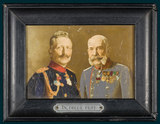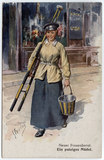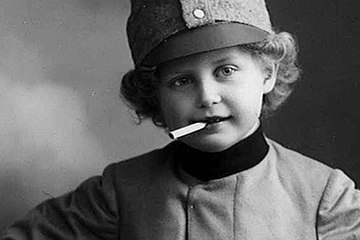“Let your hearts beat for God and your fists beat the enemy”
-

Emperor Franz Joseph and Kaiser Wilhelm II, postcard
Copyright: Schloß Schönbrunn Kultur-und Betriebsges.m.b.H./Fotograf: Alexander E. Koller
-

“God preserve, God protect our Emperor, our country!”, postcard
Copyright: Heeresgeschichtliches Museum, Wien
Partner: Heeresgeschichtliches Museum -

“With God to victory through a loyal alliance”, bookmark of the Official War Welfare Office
Copyright: Wien Museum
Partner: Wien Museum -

“New job for women. A cute girl”, postcard showing a female road-worker
Copyright: Heeresgeschichtliches Museum, Wien
Partner: Heeresgeschichtliches Museum
It was not only the messages of inflammatory propaganda that exhibited similarities in all the countries involved in the war. The subjects and forms of representation of pictorial propaganda were also astonishingly similar.
Fundamentally all states strove to represent their participation in the war as natural and ordained by God and fate. To this end a personality cult was created around the heads of state, in particular in the case of Kaiser Wilhelm and Emperor Franz Joseph, portraying them as the executors of divine will. In giving the war a political meaning it was also invested with religious and apocalyptic significance. The Allies and the Central Powers alike waged it as the ‘war to end all wars’, thus justifying the uncompromising use of all means. Military commanders appeared in pictorial propaganda as father figures standing above the people and towering above adversaries in images intended to convey confidence and hope to the people.
Images from the front were primarily intended to propagate confidence. Battle scenes invariable showed national troops charging forwards in superior numbers while the enemy was portrayed as an inferior force in retreat, even when this no longer corresponded to the reality on the ground. Propagandists resorted to existing clichés, depicting enemy troops as stereotypes. Thus German propaganda portrayed the Serbs as the epitome of uncivilized, thieving ‘Balkanese’, the Russians as uncouth and permanently drunk, the French as incapable of fighting, the British as devious and weak, and the Italians as faithless traitors.
Images of women were used to transport a variety of different messages. On the one hand as suffering victims they made the case for increased war efforts, while on the other they were shown as factory workers symbolizing the mobilization of the home front as well as the war industry. As nurses they were transformed into earthly guardian angels, embodying the longing for safety and security and becoming the objects of clandestine erotic desire. Images of children playing on the other hand were intended to downplay the war and illustrate its everyday dimension.
Depictions of military commanders or government leaders holding a globe in their hand emphasized the imperialist claims of the warring parties. Maps were used to illustrate war aims and theatres of war to obvious propagandistic effect.
Illustrated stories of the home front glossed over the privations of war and motivated people to persevere. It was emphasized that the enemy was at least as poorly supplied and that one could counter shortages with ingenuity and inventiveness. Here blame for hardship could be directed towards individuals or groups of people who were made responsible for people’s plight: profiteers, squanderers and hoarders became the internal enemy, and as such also the subject of propaganda.
At the beginning of the war propaganda met with general approval, with the population needing little convincing. This changed with the major battles at Verdun and on the Somme in 1916. As the war went on propaganda had to address the waning of the initial euphoria and emphasize the momentousness of the war. To ensure that the sacrifices already made had not been in vain, the war had to be continued until a victorious peace was assured.
Translation: Sophie Kidd
Spilker, Rolf/Ulrich, Bernd (Hrsg.): Der Tod als Maschinist. Der industrialisierte Krieg 1914-1918. Eine Ausstellung des Museums Industriekultur Osnabrück im Rahmen des Jubiläums „350 Jahre Westfälischer Friede“ Bramsche 1998
Tomenendal, Kerstin: Das Türkenbild in Österreich-Ungarn während des Ersten Weltkrieges im Spiegel der Kriegspostkarten, Klagenfurt/Wien/Ljubljana 2008
Weigl, Hans/Lukan, Walter/Peyfuss, Max: Jeder Schuss ein Russ, jeder Stoß ein Franzos. Literarische und graphische Kriegspropaganda in Deutschland und Österreich 1914-1918, Wien 1983
Zühlke, Raoul (Hrsg.), Bildpropaganda im Ersten Weltkrieg, Hamburg 2000
-
Chapters
- Propaganda: psychological warfare in the First World War
- The battle for hearts and minds.
- Friend and foe – guilt and innocence in First World War propaganda
- “Let your hearts beat for God and your fists beat the enemy”
- The First World War as reflected in the distortions of caricature
- The war on the wall
- Truth from the clouds
- The Emperor’s Voice
- Tones and Sounds






